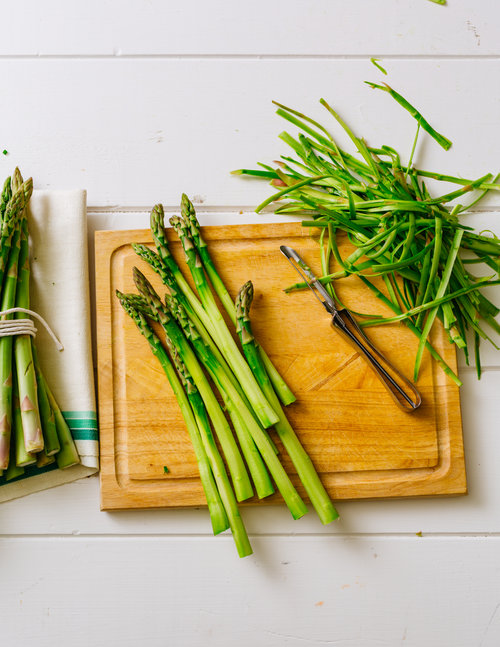One Ingredient: Asparagus
Photo by Michael Piazza / Styled by Catrine Kelty
By the time the first little purply-green shoots of the Massachusetts asparagus crop begin to emerge from the soil, spring is well underway. For four to six glorious weeks in May and June, local asparagus is on every menu and in every grocer and farm stand around. Many gardeners who wisely planted perennial crowns now enjoy spear after homegrown spear all spring. It’s an early treat that proves summer is on its way, and despite the fact that lesser-quality, imported asparagus is available to us year round, when the local asparagus arrives, we gorge on it.
Massachusetts has a long history with asparagus, both in the better-known “Hadley-Grass” western region and right here in Worcester and Middlesex counties. First cultivated from a wild plant as early as 200 BC around the Mediterranean and Middle East, the town of West Brookfield near the Quabbin Reservoir holds claim to being the birthplace of asparagus in the New World, brought here by a Dutch tradesman in the 1780s. The delicious crop grew in popularity and was cultivated in wide production all over the Commonwealth through the early-to-mid 20th century, with Hadley coming to be known as the “asparagus capital of the world.”
Closer to home, the rich, fertile, and well-drained soil of the Sudbury River valley in Concord was also well-suited to growing asparagus, and so it became an important crop in the late 19th and early 20th centuries. According to farmer Steve Verrill, “the railroad came through Concord to Boston making for quick and easy delivery of the very fresh, early spring crop to a lucrative market. At one point, Concord produced 50% of the Massachusetts crop, and it was the leading producing town in the entire country. But around 1920 the disease, ‘asparagus rust,’ became a serious problem for farmers. The University of Massachusetts established the ‘Asparagus Experiment Station’ in Concord in an unsuccessful attempt to find a solution. No commercial asparagus was planted for many decades until we started a new field at Verrill Farm, nearly 30 years ago, with some newer hybrids that are more disease-resistant, and we have been replacing that first planting with new ones, a few at a time.” Verrill’s asparagus beds are thriving, and much of the local asparagus we find in restaurants and farmers markets comes from his fields, or from Ward’s Berry Farm in Sharon.
In the 1970s, when another blight decimated the majority of Hadley’s harvest, most of the area’s farmers turned away from asparagus towards easier crops like tobacco and corn, and the domestic asparagus business moved away from Massachusetts to California, Michigan, and New Jersey. In recent years, Peru, Mexico and China have overtaken the US in industrial asparagus production, so a lot of what we find in the off-season is imported.
With woody ends, squishy tips, and stringy stalks, the quality of these bunches is vastly diminished by their lengthy travel and long storage, worlds away from the sweet, snappy spears picked right here in our back yard. Just because a vegetable is available year round doesn’t mean it’s delicious year round. Some crops are simply worth waiting for!
As I do each season, I have reached out to a few local chefs for their take on local asparagus. Add these delicious recipes to your docket this spring, and as soon as the first bunches appear in shops, celebrate the bounty of this fleeting harvest.
RECIPES
This story appeared in the Spring 2016 issue.






